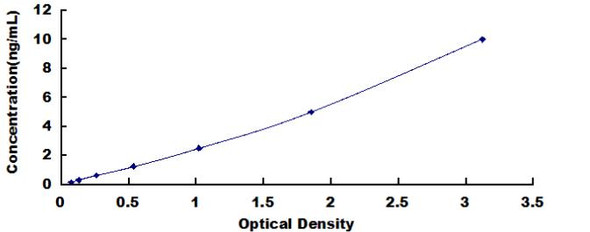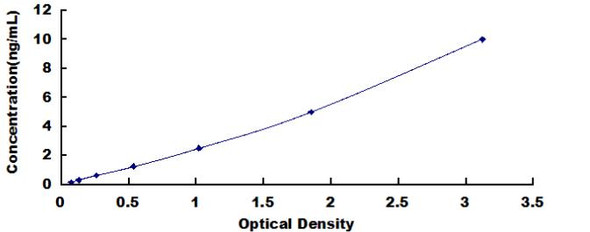Human Proto-oncogene c-Fos (FOS) ELISA Kit (HUEB1356)
- SKU:
- HUEB1356
- Product Type:
- ELISA Kit
- Size:
- 96 Assays
- Uniprot:
- P01100
- Range:
- 0.312-20 ng/mL
- ELISA Type:
- Sandwich
- Synonyms:
- FOS, Proto-oncogene c-Fos, Cellular oncogene fos, G0, G1 switch regulatory protein 7, G0S7
- Reactivity:
- Human
Description
Human Proto-oncogene c-Fos (FOS) ELISA Kit
The Human Proto-Oncogene c-Fos (FOS) ELISA Kit is a reliable tool for the quantitative measurement of c-Fos levels in human serum, plasma, and cell culture supernatants. With its high sensitivity and specificity, this kit provides accurate and reproducible results, making it suitable for various research applications.c-Fos is a proto-oncogene that plays a critical role in cell growth, differentiation, and survival. Its dysregulation has been implicated in various types of cancer, making it a valuable biomarker for studying tumorigenesis and developing targeted therapies.
By detecting c-Fos levels, researchers can gain insights into the molecular mechanisms underlying cancer progression and potentially identify new therapeutic targets.Overall, the Human Proto-Oncogene c-Fos (FOS) ELISA Kit offers a reliable and efficient means of studying the role of c-Fos in cancer and other diseases, providing researchers with valuable insights for advancing their scientific knowledge and developing innovative treatments.
| Product Name: | Human Proto-oncogene c-Fos (FOS) ELISA Kit |
| SKU: | HUEB1356 |
| Size: | 96T |
| Target: | Human Proto-oncogene c-Fos (FOS) |
| Synonyms: | Cellular oncogene fos, G0/G1 switch regulatory protein 7, G0S7 |
| Assay Type: | Sandwich |
| Detection Method: | ELISA |
| Reactivity: | Human |
| Detection Range: | 0.312-20ng/mL |
| Sensitivity: | 0.12ng/mL |
| Intra CV: | 5.8% | ||||||||||||||||||||
| Inter CV: | 8.9% | ||||||||||||||||||||
| Linearity: |
| ||||||||||||||||||||
| Recovery: |
| ||||||||||||||||||||
| Function: | Nuclear phosphoprotein which forms a tight but non-covalently linked complex with the JUN/AP-1 transcription factor. In the heterodimer, FOS and JUN/AP-1 basic regions each seems to interact with symmetrical DNA half sites. On TGF-beta activation, forms a multimeric SMAD3/SMAD4/JUN/FOS complex at the AP1/SMAD-binding site to regulate TGF-beta-mediated signaling. Has a critical function in regulating the development of cells destined to form and maintain the skeleton. It is thought to have an important role in signal transduction, cell proliferation and differentiation. In growing cells, activates phospholipid synthesis, possibly by activating CDS1 and PI4K2A. This activity requires Tyr-dephosphorylation and association with the endoplasmic reticulum. |
| Uniprot: | P01100 |
| Sample Type: | Serum, plasma, tissue homogenates, cell culture supernates and other biological fluids |
| Specificity: | Natural and recombinant human Proto-oncogene c-Fos |
| Sub Unit: | Heterodimer; with JUN (By similarity). Interacts with MAFB (By similarity). Component of the SMAD3/SMAD4/JUN/FOS complex required for synergistic TGF-beta-mediated transcription at the AP1 promoter site. Interacts with SMAD3; the interaction is weak even on TGF-beta activation. Interacts with MAFB. Interacts with DSIPI; this interaction inhibits the binding of active AP1 to its target DNA. Interacts with CDS1 and PI4K2A. |
| Research Area: | Cancer |
| Subcellular Location: | Nucleus Endoplasmic reticulum Cytoplasm Cytosol In quiescent cells, present in very small amounts in the cytosol. Following induction of cell growth, first localizes to the endoplasmic reticulum and only later to the nucleus. Localization at the endoplasmic reticulum requires dephosphorylation at Tyr-10 and Tyr-30. |
| Storage: | Please see kit components below for exact storage details |
| Note: | For research use only |
| UniProt Protein Function: | Fos: a proto-oncogenic transcription factor of the bZIP family. Dimerizes with proteins of the JUN family, thereby forming the transcription factor complex AP-1. FOS proteins function as regulators of cell proliferation, differentiation, and transformation. In some cases, expression of FOS has also been associated with apoptotic cell death. Expression increases upon a variety of stimuli, including growth factors, cytokines, neurotransmitters, polypeptide hormones, stress and cell injury. |
| UniProt Protein Details: | Protein type:Motility/polarity/chemotaxis; DNA-binding; Transcription factor; Oncoprotein Chromosomal Location of Human Ortholog: 14q24.3 Cellular Component: nucleoplasm; transcription factor complex; neuron projection; membrane; endoplasmic reticulum; nucleus; cytosol Molecular Function:protein binding; double-stranded DNA binding; transcription factor activity; transcription factor binding Biological Process: transcription from RNA polymerase II promoter; response to gravity; response to cAMP; positive regulation of osteoclast differentiation; positive regulation of transcription, DNA-dependent; response to toxin; stress-activated MAPK cascade; response to lipopolysaccharide; toll-like receptor 3 signaling pathway; female pregnancy; toll-like receptor 10 signaling pathway; toll-like receptor 5 signaling pathway; regulation of transcription factor activity; transforming growth factor beta receptor signaling pathway; conditioned taste aversion; DNA methylation; inflammatory response; toll-like receptor 4 signaling pathway; aging; response to corticosterone stimulus; response to drug; response to light stimulus; nervous system development; MyD88-independent toll-like receptor signaling pathway; sleep; toll-like receptor 2 signaling pathway; cellular response to hormone stimulus; regulation of transcription from RNA polymerase II promoter; MyD88-dependent toll-like receptor signaling pathway; response to mechanical stimulus; response to cytokine stimulus; cellular response to extracellular stimulus; toll-like receptor signaling pathway; innate immune response; positive regulation of transcription from RNA polymerase II promoter; response to cold; toll-like receptor 9 signaling pathway; response to progesterone stimulus |
| NCBI Summary: | The Fos gene family consists of 4 members: FOS, FOSB, FOSL1, and FOSL2. These genes encode leucine zipper proteins that can dimerize with proteins of the JUN family, thereby forming the transcription factor complex AP-1. As such, the FOS proteins have been implicated as regulators of cell proliferation, differentiation, and transformation. In some cases, expression of the FOS gene has also been associated with apoptotic cell death. [provided by RefSeq, Jul 2008] |
| UniProt Code: | P01100 |
| NCBI GenInfo Identifier: | 120470 |
| NCBI Gene ID: | 2353 |
| NCBI Accession: | P01100.1 |
| UniProt Secondary Accession: | P01100,P18849, A8K4E2, B4DQ65, |
| UniProt Related Accession: | P01100 |
| Molecular Weight: | 380 |
| NCBI Full Name: | Proto-oncogene c-Fos |
| NCBI Synonym Full Names: | FBJ murine osteosarcoma viral oncogene homolog |
| NCBI Official Symbol: | FOS |
| NCBI Official Synonym Symbols: | p55; AP-1; C-FOS |
| NCBI Protein Information: | proto-oncogene c-Fos; activator protein 1; cellular oncogene c-fos; G0/G1 switch regulatory protein 7; FBJ murine osteosarcoma viral (v-fos) oncogene homolog (oncogene FOS) |
| UniProt Protein Name: | Proto-oncogene c-Fos |
| UniProt Synonym Protein Names: | Cellular oncogene fos; G0/G1 switch regulatory protein 7 |
| Protein Family: | Fos-related antigen |
| UniProt Gene Name: | FOS |
| UniProt Entry Name: | FOS_HUMAN |
| Component | Quantity (96 Assays) | Storage |
| ELISA Microplate (Dismountable) | 8×12 strips | -20°C |
| Lyophilized Standard | 2 | -20°C |
| Sample Diluent | 20ml | -20°C |
| Assay Diluent A | 10mL | -20°C |
| Assay Diluent B | 10mL | -20°C |
| Detection Reagent A | 120µL | -20°C |
| Detection Reagent B | 120µL | -20°C |
| Wash Buffer | 30mL | 4°C |
| Substrate | 10mL | 4°C |
| Stop Solution | 10mL | 4°C |
| Plate Sealer | 5 | - |
Other materials and equipment required:
- Microplate reader with 450 nm wavelength filter
- Multichannel Pipette, Pipette, microcentrifuge tubes and disposable pipette tips
- Incubator
- Deionized or distilled water
- Absorbent paper
- Buffer resevoir
*Note: The below protocol is a sample protocol. Protocols are specific to each batch/lot. For the correct instructions please follow the protocol included in your kit.
Allow all reagents to reach room temperature (Please do not dissolve the reagents at 37°C directly). All the reagents should be mixed thoroughly by gently swirling before pipetting. Avoid foaming. Keep appropriate numbers of strips for 1 experiment and remove extra strips from microtiter plate. Removed strips should be resealed and stored at -20°C until the kits expiry date. Prepare all reagents, working standards and samples as directed in the previous sections. Please predict the concentration before assaying. If values for these are not within the range of the standard curve, users must determine the optimal sample dilutions for their experiments. We recommend running all samples in duplicate.
| Step | |
| 1. | Add Sample: Add 100µL of Standard, Blank, or Sample per well. The blank well is added with Sample diluent. Solutions are added to the bottom of micro ELISA plate well, avoid inside wall touching and foaming as possible. Mix it gently. Cover the plate with sealer we provided. Incubate for 120 minutes at 37°C. |
| 2. | Remove the liquid from each well, don't wash. Add 100µL of Detection Reagent A working solution to each well. Cover with the Plate sealer. Gently tap the plate to ensure thorough mixing. Incubate for 1 hour at 37°C. Note: if Detection Reagent A appears cloudy warm to room temperature until solution is uniform. |
| 3. | Aspirate each well and wash, repeating the process three times. Wash by filling each well with Wash Buffer (approximately 400µL) (a squirt bottle, multi-channel pipette,manifold dispenser or automated washer are needed). Complete removal of liquid at each step is essential. After the last wash, completely remove remaining Wash Buffer by aspirating or decanting. Invert the plate and pat it against thick clean absorbent paper. |
| 4. | Add 100µL of Detection Reagent B working solution to each well. Cover with the Plate sealer. Incubate for 60 minutes at 37°C. |
| 5. | Repeat the wash process for five times as conducted in step 3. |
| 6. | Add 90µL of Substrate Solution to each well. Cover with a new Plate sealer and incubate for 10-20 minutes at 37°C. Protect the plate from light. The reaction time can be shortened or extended according to the actual color change, but this should not exceed more than 30 minutes. When apparent gradient appears in standard wells, user should terminatethe reaction. |
| 7. | Add 50µL of Stop Solution to each well. If color change does not appear uniform, gently tap the plate to ensure thorough mixing. |
| 8. | Determine the optical density (OD value) of each well at once, using a micro-plate reader set to 450 nm. User should open the micro-plate reader in advance, preheat the instrument, and set the testing parameters. |
| 9. | After experiment, store all reagents according to the specified storage temperature respectively until their expiry. |
When carrying out an ELISA assay it is important to prepare your samples in order to achieve the best possible results. Below we have a list of procedures for the preparation of samples for different sample types.
| Sample Type | Protocol |
| Serum | If using serum separator tubes, allow samples to clot for 30 minutes at room temperature. Centrifuge for 10 minutes at 1,000x g. Collect the serum fraction and assay promptly or aliquot and store the samples at -80°C. Avoid multiple freeze-thaw cycles. If serum separator tubes are not being used, allow samples to clot overnight at 2-8°C. Centrifuge for 10 minutes at 1,000x g. Remove serum and assay promptly or aliquot and store the samples at -80°C. Avoid multiple freeze-thaw cycles. |
| Plasma | Collect plasma using EDTA or heparin as an anticoagulant. Centrifuge samples at 4°C for 15 mins at 1000 × g within 30 mins of collection. Collect the plasma fraction and assay promptly or aliquot and store the samples at -80°C. Avoid multiple freeze-thaw cycles. Note: Over haemolysed samples are not suitable for use with this kit. |
| Urine & Cerebrospinal Fluid | Collect the urine (mid-stream) in a sterile container, centrifuge for 20 mins at 2000-3000 rpm. Remove supernatant and assay immediately. If any precipitation is detected, repeat the centrifugation step. A similar protocol can be used for cerebrospinal fluid. |
| Cell culture supernatant | Collect the cell culture media by pipette, followed by centrifugation at 4°C for 20 mins at 1500 rpm. Collect the clear supernatant and assay immediately. |
| Cell lysates | Solubilize cells in lysis buffer and allow to sit on ice for 30 minutes. Centrifuge tubes at 14,000 x g for 5 minutes to remove insoluble material. Aliquot the supernatant into a new tube and discard the remaining whole cell extract. Quantify total protein concentration using a total protein assay. Assay immediately or aliquot and store at ≤ -20 °C. |
| Tissue homogenates | The preparation of tissue homogenates will vary depending upon tissue type. Rinse tissue with 1X PBS to remove excess blood & homogenize in 20ml of 1X PBS (including protease inhibitors) and store overnight at ≤ -20°C. Two freeze-thaw cycles are required to break the cell membranes. To further disrupt the cell membranes you can sonicate the samples. Centrifuge homogenates for 5 mins at 5000xg. Remove the supernatant and assay immediately or aliquot and store at -20°C or -80°C. |
| Tissue lysates | Rinse tissue with PBS, cut into 1-2 mm pieces, and homogenize with a tissue homogenizer in PBS. Add an equal volume of RIPA buffer containing protease inhibitors and lyse tissues at room temperature for 30 minutes with gentle agitation. Centrifuge to remove debris. Quantify total protein concentration using a total protein assay. Assay immediately or aliquot and store at ≤ -20 °C. |
| Breast Milk | Collect milk samples and centrifuge at 10,000 x g for 60 min at 4°C. Aliquot the supernatant and assay. For long term use, store samples at -80°C. Minimize freeze/thaw cycles. |
| Piotr Józef Olbromski et al. | Identification of New Molecular Biomarkers in Ovarian Cancer Using the Gene Expression Profile | Journal of clinical medicine 2022 | PubMed ID: 35807169 |










